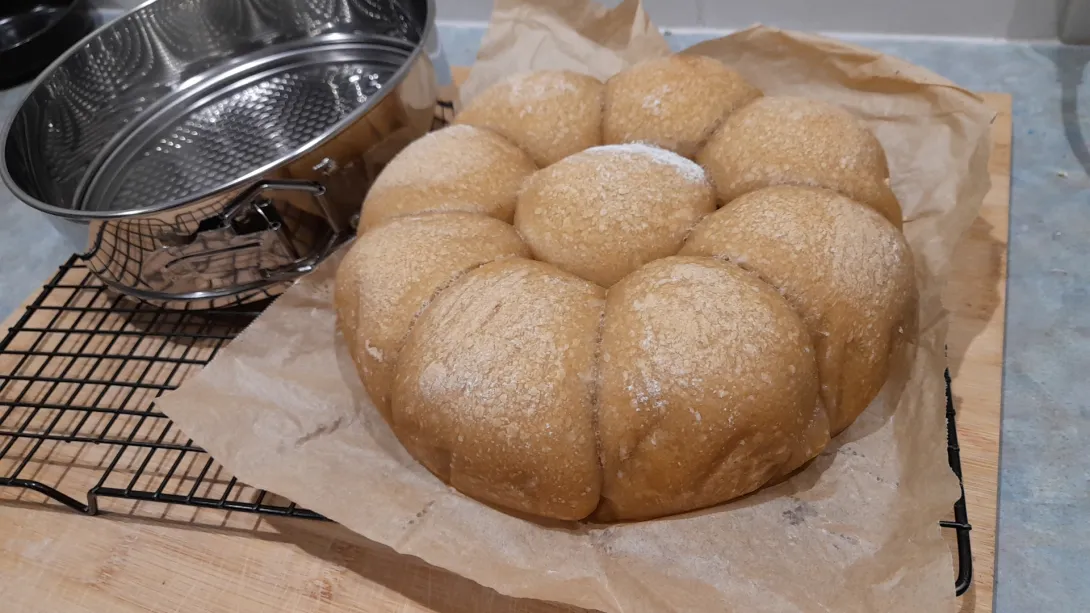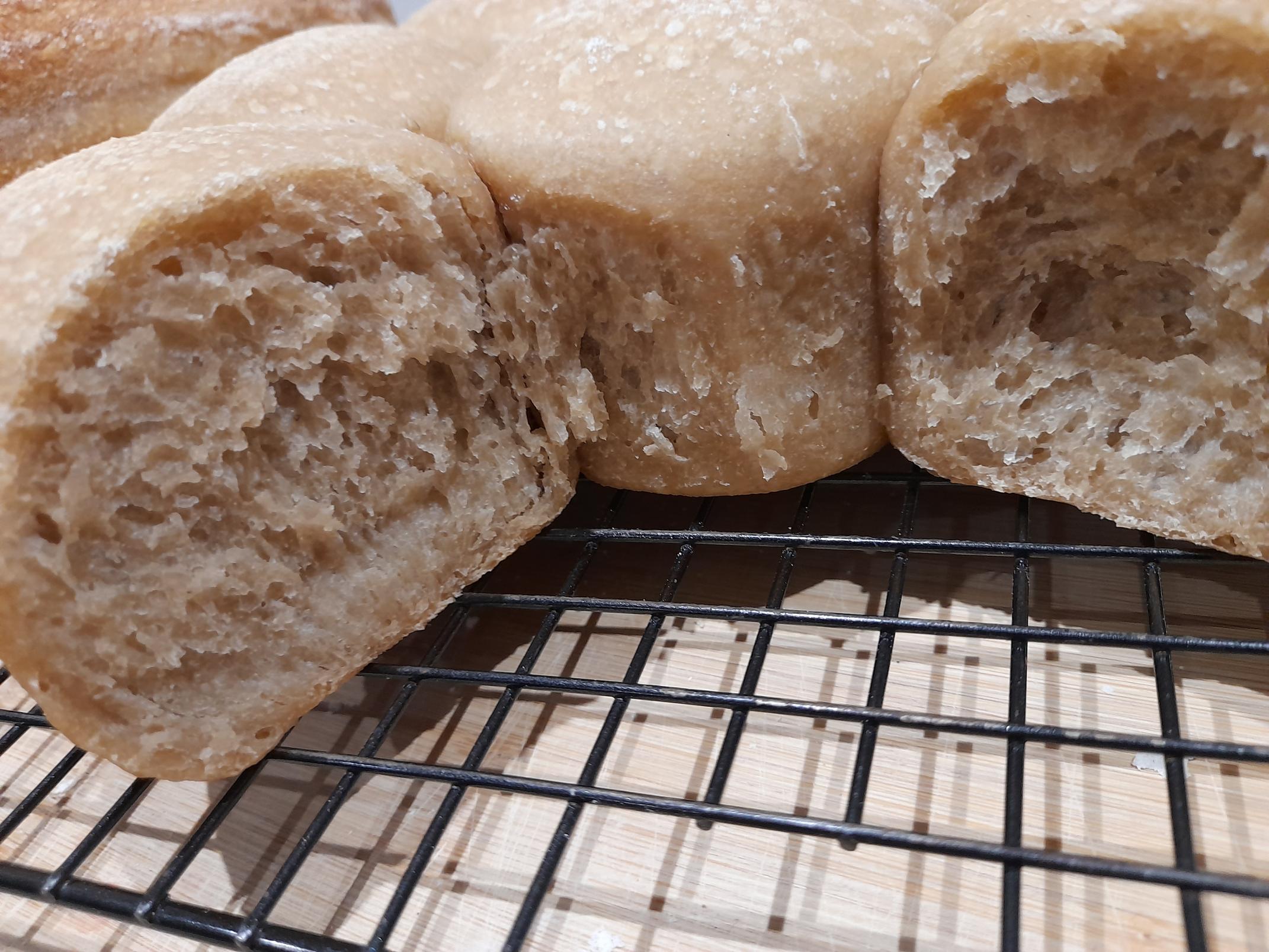
Next step in the Atta Flour Adventure was adding a little soy flour in the quest for fluffy. And I think I finally got it!
First out of the oven is this batch of pull apart rolls. (The loaf made with the other half of the dough is out of the oven, but still too hot to slice. I will add photos later. Fingers are crossed the crumb is just like this...)

800g water
952g chakki atta flour
28g vital wheat gluten
20g soy flour
0.5 tsp diastatic malt
1.5 tsp salt
100g starter (1:1 atta)
2 tbsp olive oil
Mixed water, atta flour, vwg, soy flour and malt in a Bear mixer, then left to autolyse for 1 hour.
Add starter, salt and olive oil. Mix for 15 minutes.
2 sets of stretch and fold. Bulk ferment overnight at 20°C.
Shape as pull aparts and one batard. Fridge proof for about 6 hours.
Baked the rolls in a cake tin inside an enamel roaster for 30 minutes with lid, then another 5 without. Next time I would let them brown a bit more perhaps, but thankfully they taste good to us just as they are.
- AmandaW's Blog
- Log in or register to post comments
Lovely looking open crumb for atta flour - it looks like the VWG and soy flour have done the trick. I agree you need to bake a bit longer to get some more colour in the crust.
Lance
Already next day loaf made with half of yesterday's dough. Baked in a ceramic Aldi loaf pan. It took 55 mins in the oven to get to 96°C - lid on for just the first 25 minutes.
That looks fantastic, you've made a huge amount of progress in just a few bakes! Is this where you want your bread to be, or are you hoping for more openness?
Did you notice the soy flour affecting the flavor of the bread at all? I have used chickpea flour in the past (which supposedly works the same as the soy flour for gluten development/openness, but I didn't see a difference in that regard) and I felt there was a barely-there effect on the flavor; it's possible I imagined it, though.
I'm really looking forward to see what you do next. Thank you for sharing your work!
We have one that never gets used.
Thankyou for the interest and encouragement. It's much appreciated. :-)
I couldn't taste any change from the soy flour. It is a small amount: 20g in a kilo of dough. Would adding more get a more open crumb? I recall reading about it making gluten weaker if too much is used. I will test that by increasing over a few bakes.
My next change however is to swap the olive oil for avocado oil. The olive oil flavour is too strong for me (and could mask a soy flour change!) I read that avocado oil is milder and better for higher temperatures so seems to be a better choice. That's going in today's bake.
I plan to try scalding some of the flour. Maybe next. I'm trying to get a good understanding of soft / fluffy / open with chakki atta... then I get to play with partial changes of the atta with other flours (spelt, rye, khorasan) and add ins such as oats and seeds. One change at a time.
The spring form pan was baked inside a big round enamel roaster. Ancient thing,. The kind that is found in a thrift store. Great for cheap steam.
Here's a link to a thread where the effects of fava bean and chickpea flour are described; I think I've read elsewhere that soy flour also has the some effect, but I can't remember where I found that, sorry. Soy flour also contains some lecithin, but I'm not sure if it has the usual effects on dough as lecithin when it's incorporated in whole soy flour.
I will say that contrary to what was described in that comment, I have found that ascorbic acid (aka vitamin C) can have a bleaching effect in high enough quantities. Dramatically so, even. The loaf I put too much in continued to lose color even in the freezer over the course of two weeks. Elsewhere I have read that the oxidation additionally reduces flavor, though I wasn't able to notice a difference in that loaf because the inclusions were strongly flavored.
So there is definitely a trade off to adding more of these bean flours or vitamin C that you should be aware of. 2% doesn't sound like a lot but that's the highest I've seen recommended for fava bean/chickpea/soy flour. If you want to try a higher amount, it might be wise to test on a small batch, or at least not double.
Indeed, bean flours are a rich source of lipoxygenase (LOX) enzymes, this includes Soy as well as Chickpea and Fava. However it depends on whether these flours have been heat-treated which would make them enzyme-inactive. Soy as a source of lecithin is typically added to provide a finer, more even and stable crumb in commercial baking but Soy also has a number of other "improving" properties.
Addition of ascorbic acid helps to give a higher rising bread with a soft and airy crumb which can give the impression of a lighter and whiter appearance. However, ascorbic acid does not possess the ability to bleach dough by stripping carotenoids of their creamy-yellow colour. To oxidise carotenoids a stronger reactive oxygen species (ROS) is required to break it down. Lipoxygenase generates a ROS in the form of a peroxyl radical which then attacks carotenoids pigments.
Once the bread is cooked, these enzymes are neutralised and biological (enzymatic) transformations don't occur while frozen. I'm guessing ice crystals contributed to a whiter appearance.
To get the gluten strengthening effects, ascorbic acid must first be oxidised to DHA by naturally present Ascorbate Oxidase (AAO). DHA is the actual oxidising agent which facilitates the formation of strong disulphide bonds between gluten molecules, strengthening the gluten network.
Ascorbic acid (AA) + Oxygen = Dehydroascorbic acid (DHA).
Adding too much ascorbic acid could make the dough too stiff but in really excessive amounts it will have the opposite effect and work in its natural form as a reducing agent because not all the AA is converted to DHA. Thereby slackening the dough. Similarly, mixing dough under vacuum with ascorbic acid, without access to molecular oxygen, AA will not convert to DHA thus it will function as a reducing agent.
These oxidising enzymes LOX, AAO require molecular oxygen to function and they direct that oxygen toward specific reactions. Under normal circumstances, without the addition of other oxidising substances e.g.; benzoyl peroxide, lipoxygenase primarily mediates the breakdown of carotenoid pigments and is limited by oxygen incorporation during mixing.
Counter intuitively, oxidation of carotenoids creates flavour compounds! But as bakers we don't feel that and associate colour loss with flavour loss. Oxidation of carotenoids to flavour compounds is probably more appreciated in winemaking :)
Thankyou for the link. Based on the 2% being a suggested maximum of soy flour, I will try a bake with just 1%.
And chickpea flour... I have that on the pantry already. An easy swap to test.
Changing the oil from olive to avocado was a success. No green tinge to the loaf when it first came out of the oven... And the wheat getting to be the star. Olive oil would be chosen if I were making pizza etc, but not for most other breads.
The Change One Thing with today's bake was reducing the avocado oil by half. It still turned out soft inside with a thin crispy crust. Two small loaves means it will be eaten over the next few or more days - only then will I know if the keeping quality is reduced as well...
800g water
752g chakki atta flour
28g vital wheat gluten
20g soy flour
0.5 tsp diastatic malt
1.5 tsp salt
100g starter (1:1 atta)
1 tbsp avocado oil
Autolyse water flours and malt for 1 hour. Add starter, salt and oil and mix with a Bear dough mixer for 15 minutes. Stretch & fold twice. Bulk ferment overnight.
Shape to fit two 21x11x12cm pans. Bake inside a pair of large Ikea roasting pans to contain steam. 25 mins withe lid on plus 15 minutes without til they reached 96°C.